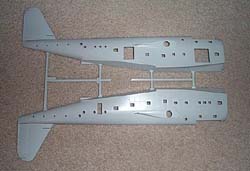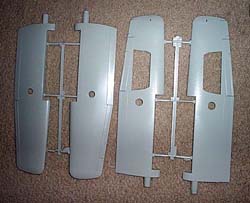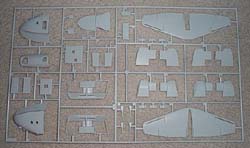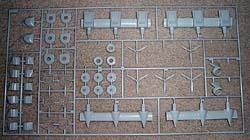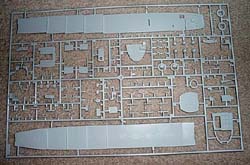Revell-Germany 1/72 BLOHM UND VOSS BV-222 V-2 "VIKING" Kit no. 04383
MSRP: $30.50
GreatModels Price: $21.95 |  | HISTORY: The BV-222 was designed to meet the requirements of Deutsche Lufthansa for a long-range flying-boat for flights across the north and south Atlantic. With a take-off weight of 45 tons, the aircraft was to transport 24 passengers on day-time flights and 16 passengers when sleeping amenities were required. The aircraft's first flight on September 7th, 1940 however took place during World War II when aircraft with long-range capacity and large cargo compartments met with the particular interest of the military. So, with a civilian crew, the BV-222 V1 flew its first sortie for the Luftwaffe (German Air Force) on July 10th, 1941 for evaluation. It could transport 92 fully equipped troops or 72 casualties on stretchers. With a wing span of 45 meters and six engines, it was the largest flying-boat in service in the Second World War. It reached a maximum speed of 385 km/h at 4,500 m altitude and had a range of 7,000 km. The 7th of August 1941 saw the first flight of the BV-222 V2 (subject of this kit) which, following the experience with the V1 model, was fitted with defensive armament. The bow held one MG 81, two dorsal turrets were equipped with MG 131s. Additionally, in the event of an attack a further four MG 81s could be fitted in the window bays. The armament also comprised two weapon stations with two MG 131s each, mounted in gondolas which were located between the two exterior engines. Equipped like this, the V2 was meant to operate as a long-range reconnaissance aircraft under the command of the "Fliegerfuehrer Atlantik". Changes in the design during the evaluation period, however, prevented this use and it was not until these alterations were completed that the V2 model became operational with LTS 173 See (Lufttransportfuehrer See 222) on August 10th 1942 as a transport plane before finally seeing service as previously planned as a long-range reconnaissance aircraft with 1./SAGr. 129 at Biscarosse, France. During the whole period of its operational service, the V2 continuously altered its appearance. Shortly after its first flight, the gondola armament was removed, the rear rotating-turret was dismounted and some windows in the bow omitted from the design. Specially for its use for long-range reconnaissance missions, it received FuG 200 "Hohentwiel" search radar, a type of ASV (air-to-surface-vessel search radar) with three antennae mounted in the bow as well as FuG 216B rear-view warning radar fitted on top of the wings. I July 1944, the V2 attracted attention during Operation "Schatzgraeber" ("Treasure Digger"). Schatzgraeber was the code name of a German weather station on Alexandera-land in the Arctic, the crew of which had fallen ill and was to be evacuated by an Fw-200C-3 of KG 40. During the landing, the undercarriage of the Fw-200 aircraft was damaged. The rescue operation had to be extended, which also involved the V2 ordered from Biscarosse for the sea rescue and supply role. Specially, for this sortie, a winter camouflage coat of removable white paint was applied on top of the standard camouflage pattern in the Billefjord, Norway. The marking "B4-BH" and the German insignia remained in view. The BV-222 V2 dropped the required spare parts and further supplies over the weather station on July 8th, 1944, as a landing in those waters proved to be impossible. After that, the rescue operation went according to plan. What's in the box?: Make no mistake folks, this is a BIG one!! It comes in a huge tray and lid box that measures 20" x 14" x 3.5". The box art shows the V2 over-flying a U-boat, at dawn, with a full moon just dropping below the horizon. A side panel shows five photos of various areas on a completed model. Inside, one huge cello bag holds all but the decal sheet and instructions. There are three more cello bags, further protecting trees, inside this bag. Parts are molded in a medium gray plastic and the detail is great. Two fuselage halves are on the first tree. These are molded with the vertical tail surfaces included. However, the nose of the aircraft is separate pieces. This tree spans the whole box tightly. The first large tree holds floor pieces, bulkheads, doors, guns, radar antenna etc. (120 parts here). The second large tree holds the horizontal tail surfaces, the fuselage nose pieces, wing float pieces, more bulkheads etc. (37 parts here). The third large tree holds engine cowling parts and props - I found about 10 of the parts from this tree had broken off the tree and were floating around loose in the cello bag . (54 parts here) The wing halves are on 2 more trees. The final tree is all the clear parts and there are a lot of windows in this aircraft. (48 parts) The instructions consist of 20 pages in a 12" x 8.5" format. Page 1 starts with a black and white photo of a completed model, followed by the history of the aircraft in German and English. Page 2 is some "READ BEFORE YOU START" instructions. Page 3 shows the interpretations for the assembly symbols. Page 4 gives the color codes. Page 5 shows parts tree drawings. The top of page 6 shows some more parts tree drawings, followed by the first five assembly steps. Pages 7 through 17 give the remaining assembly steps. There are 71 in all. Pages 18, 19, and 20 give us three paint schemes for the V2 at different points in its operational career: With the 1/SAGr. 129 Bicarosse, France 1944
With LTS 222, 1943
In its temporary winter white paint scheme. There are no figures included in the kit. The decal sheet is large and impressive, with lots of stencil marks. However, because this kit is marketed in Germany, there are no swastikas included. So, you will have to find some in your spares box. This plane is so big that ones that you would normally use on a 1/48th scale fighter will probably work here. Conclusion I have been waiting for this kit with bated breath, ever since I heard it announced as being in the works from Revell of Germany. It was well worth waiting for and all the plastic in the box is a bargain at the asking price. I purchased this kit from GreatModels web store. | 








|

